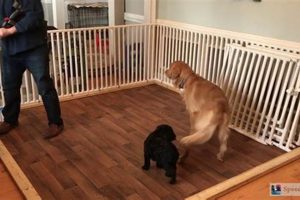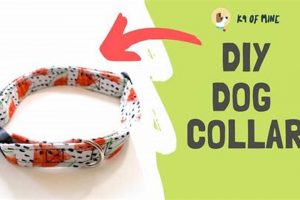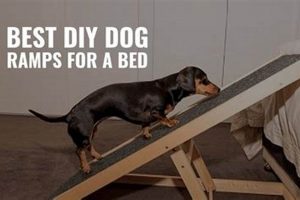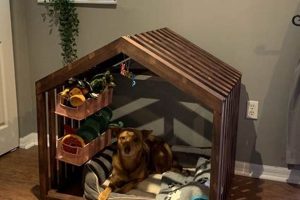Structures designed to aid canines in accessing elevated surfaces, specifically beds, and constructed through do-it-yourself methods, represent an increasingly popular solution for pet owners. These fabricated aids typically involve a series of steps or platforms, enabling smaller or aging dogs, or those with mobility limitations, to ascend and descend safely, preventing potential injuries associated with jumping.
The impetus behind creating personalized canine access solutions stems from various factors, including concerns for the animal’s joint health, particularly in breeds predisposed to conditions like hip dysplasia. Furthermore, these custom-built aids provide independence for pets, allowing them to access desired resting places without requiring human assistance. Historically, makeshift solutions were common; however, the availability of online tutorials and readily accessible materials has facilitated a surge in more sophisticated and aesthetically pleasing designs.
Subsequent sections will delve into specific construction techniques, material considerations, safety protocols, and design options for creating elevated access points for canine companions. This will include an exploration of structural integrity, fabric selection, and adaptation for diverse canine needs and home environments.
Construction Tips for Canine Bed Access Structures
The following tips offer practical guidance for individuals undertaking the creation of elevated access solutions for their canine companions. Attention to detail and adherence to safety principles are paramount in ensuring a successful and functional outcome.
Tip 1: Material Selection: Prioritize durable, non-toxic materials that can withstand the intended weight. Solid wood, such as pine or plywood, provides a stable base. Avoid particleboard due to its potential for structural weakness and off-gassing.
Tip 2: Precise Measurement: Accurately measure the height of the bed and the available floor space. Proper measurements are crucial for determining the number of steps, step height, and overall dimensions of the structure, thereby maximizing safety and usability.
Tip 3: Stable Base Construction: Ensure a wide and stable base for the unit to prevent tipping. Reinforce corners with brackets or wood glue for added strength. Consider adding rubber feet to prevent slippage on hard floors.
Tip 4: Optimal Step Height and Depth: Design steps with a comfortable rise (height) and run (depth) for the dog’s breed and size. A shallower step height is preferable for smaller breeds or dogs with mobility issues. Adequate depth allows for a secure footing.
Tip 5: Secure Tread Surfaces: Apply a non-slip surface to each step. Carpet remnants, textured paint, or adhesive treads enhance traction and prevent accidental slips. Ensure the chosen material is securely attached to the step.
Tip 6: Smooth Edges and Corners: Sand all edges and corners to eliminate sharp points that could cause injury. Consider using rounded trim to further soften edges and enhance safety.
Tip 7: Weight Testing: Before allowing the dog to use the structure, test its weight-bearing capacity. Apply consistent pressure across each step to identify any potential weaknesses in the construction.
By implementing these guidelines, builders can significantly enhance the safety, stability, and usability of custom-designed canine bed access solutions, ensuring the long-term well-being of their pets.
The subsequent section addresses aesthetic considerations and customization options to seamlessly integrate the structure into the home environment.
1. Dimensions
Dimensional accuracy is paramount to the success and safety of any do-it-yourself project intended to facilitate canine access to beds. Incorrect measurements or poorly proportioned steps can render the structure unusable or, worse, pose a risk of injury to the animal. Precise calculations are therefore essential.
- Overall Height Matching
The culminating height of the structure must precisely match the height of the bed. A height differential, even a small one, can lead to hesitant use by the dog, or potentially cause a misstep resulting in a fall. Real-world examples demonstrate that even seemingly minor discrepancies are often noticeable to the animal, affecting its confidence in using the stairs. For instance, if the stairs are even an inch taller than the bed, smaller dogs may be unable to comfortably climb the stairs.
- Step Height Consistency
Consistency in the rise (height) of each individual step is crucial. Irregular step heights can disrupt the dog’s gait, increasing the likelihood of stumbles or falls. A uniform step height promotes confidence and stability during ascent and descent. An inconsistent rise may be dangerous and cause the pet to fall.
- Step Depth Adequacy
The depth (tread) of each step must be sufficient to accommodate the dog’s paw size comfortably. A shallow step depth provides inadequate surface area for secure footing, particularly during descent. For example, a small breed might manage with a step depth of 6 inches, whereas a larger breed would require 10-12 inches for comfortable use.
- Width Considerations
The width of the structure must accommodate the dog’s body size, allowing ample room for comfortable movement without feeling constricted. Insufficient width can lead to hesitation or awkward maneuvering, especially for larger breeds. The stairs should be wider than the pet’s shoulder. For instance, small stairs will not be useful for big pets.
In essence, the dimensional aspects of the constructed aid must be meticulously tailored to the specific canine user. Failure to accurately account for the animal’s size, breed, and physical capabilities compromises the intended function and introduces potential safety hazards, negating the benefits of a do-it-yourself solution.
2. Materials
Material selection is a paramount consideration in the design and construction of canine bed access aids. The chosen materials dictate the structural integrity, longevity, safety, and aesthetic appeal of the finished product. Each material possesses unique characteristics that must be carefully evaluated in relation to the intended purpose.
- Wood
Wood represents a common choice due to its inherent strength, workability, and aesthetic versatility. Solid wood species, such as pine, oak, or maple, provide robust structural support. Plywood offers an economical alternative but requires careful edge treatment to prevent splintering. Reclaimed wood presents an environmentally conscious option, although its structural integrity must be thoroughly assessed. Wood selection depends on various factor such as humidity and location.
- Fabric and Carpeting
Textile coverings applied to the steps enhance traction and provide a comfortable surface for the dog’s paws. Durable, low-pile carpeting or non-slip fabric remnants are frequently employed. Material selection should prioritize resistance to wear and tear, ease of cleaning, and absence of loose fibers that could pose a choking hazard. Color matching with interiors is also important factor.
- Metal
Metal components, such as brackets, screws, and bolts, play a critical role in ensuring the structural stability of the unit. Stainless steel or galvanized steel is preferred for its corrosion resistance, particularly in environments with high humidity. The appropriate selection of fasteners, based on the material being joined, is essential to prevent loosening or failure under load. Without right metal, wood material would be less stronger.
- Adhesives and Finishes
Adhesives are utilized to bond various components, such as fabric coverings or edge trim, to the underlying structure. Non-toxic, low-VOC adhesives are recommended to minimize potential health risks to the animal. Finishes, such as paints or sealants, protect the wood from moisture and wear while enhancing its aesthetic appeal. Again, non-toxic formulations are paramount to prevent ingestion or skin irritation.
In summary, the judicious selection of materials is integral to the successful fabrication of canine bed access aids. A comprehensive understanding of material properties, coupled with a commitment to safety and durability, ensures that the resulting structure effectively serves its intended purpose while minimizing potential risks to the animal.
3. Stability
The connection between stability and structures designed to facilitate canine bed access is one of direct causality and paramount importance. Instability in a fabricated access aid directly elevates the risk of injury to the animal using it. A poorly constructed, unstable structure can lead to tipping, wobbling, or collapse, resulting in falls, strains, or more severe orthopedic trauma. This critical aspect of design necessitates rigorous attention to structural integrity throughout the construction process.
The importance of stability manifests in several practical design considerations. A wide base, constructed from durable materials, provides a lower center of gravity and resists tipping forces. Secure joining methods, such as screws, bolts, and high-strength adhesives, prevent component separation. Weight distribution across the structure must be balanced to avoid localized stress points. Real-world examples frequently illustrate the consequences of neglecting stability: homemade stairs constructed from lightweight materials with inadequate bracing collapsing under the dog’s weight, or narrow, top-heavy ramps toppling over when the animal attempts to ascend or descend. Prioritizing stability isn’t merely an aesthetic consideration; it is a fundamental requirement for ensuring the safety and well-being of the canine user.
Understanding the criticality of stability in canine bed access structures highlights the need for careful planning, material selection, and construction techniques. While aesthetic preferences and cost considerations may influence design choices, these factors must never compromise the structural integrity of the unit. Challenges may arise when attempting to balance aesthetic design with structural requirements, particularly in smaller spaces. However, prioritizing safety through robust construction and meticulous attention to stability is crucial for creating a functional and injury-free solution for canines accessing elevated surfaces.
4. Incline
The angle of incline constitutes a critical variable in the design and efficacy of do-it-yourself canine bed access solutions. A steep incline increases the physical demands placed on the animal during ascent and descent, potentially exacerbating existing joint issues or increasing the risk of falls. Conversely, an excessively shallow incline may necessitate a ramp-like structure requiring an impractically large footprint within the living space. The optimal incline strikes a balance between minimizing strain and maximizing space efficiency.
The connection between incline and canine well-being is direct. For example, a dog with arthritis attempting to navigate stairs with a steep incline is likely to experience increased pain and discomfort, potentially leading to reluctance to use the structure or, worse, an injury. In contrast, a gradual incline, akin to a gentle slope, reduces the strain on joints and muscles, allowing the animal to ascend and descend with greater ease and confidence. The practical significance of understanding this relationship is evident in the design process, where careful consideration must be given to the dog’s breed, size, age, and any pre-existing physical limitations.
Ultimately, the selection of an appropriate incline represents a crucial design decision in “dog stairs for bed diy”. The angle chosen must prioritize the safety and comfort of the canine user, balancing the need for accessibility with the constraints of the available space. Overly ambitious or poorly considered incline angles compromise the entire purpose of the structure, potentially transforming a helpful aid into a hazardous obstacle. Therefore, a methodical approach to determining the ideal incline is essential for a successful and beneficial outcome.
5. Traction
The concept of traction is inextricably linked to the functionality and safety of elevated access solutions designed for canines. Adequate traction minimizes the risk of slips and falls during ascent and descent, mitigating potential injuries and promoting confident use of the structure.
- Surface Material Selection
The choice of surface material directly impacts the available traction. Smooth surfaces, such as polished wood or bare plastic, offer minimal grip, particularly when wet. Conversely, textured materials, such as low-pile carpeting, rubber treads, or specialized non-slip coatings, significantly enhance traction. Real-world examples demonstrate the efficacy of carpeted steps in preventing slips compared to those with a varnished wood finish. Consideration must be given to the durability and cleanability of the chosen material alongside its traction properties.
- Tread Pattern and Design
The pattern or design incorporated into the step surface can further augment traction. Grooves, ridges, or textured patterns provide additional points of contact for the canine’s paws, improving grip. The effectiveness of various patterns depends on the paw size and gait of the individual dog. For instance, wide, shallow grooves may be more suitable for larger breeds, while smaller dogs may benefit from finer textures. An inappropriate pattern or design may not be useful and can still cause the pet to fall.
- Environmental Considerations
Environmental factors, such as moisture and debris, can compromise traction. Damp conditions reduce the effectiveness of many surface materials, increasing the risk of slips. Regular cleaning and maintenance are essential to remove dirt, dust, and other contaminants that may accumulate on the step surfaces. Selection of materials resistant to moisture absorption is crucial in humid environments. Failure to consider environmental consideration may reduce the quality and increase the danger of the stairs.
- Angle of Incline Influence
Traction requirements are amplified with steeper inclines. A more gradual incline reduces the demand for high levels of traction, as the dog’s weight is distributed more evenly. A steeper incline, however, necessitates a surface material with exceptional grip to prevent sliding. The interaction between incline and traction underscores the importance of holistic design, where multiple factors are considered in concert to optimize safety and functionality.
In conclusion, the provision of adequate traction is an indispensable aspect of effective “dog stairs for bed diy”. Surface material, tread pattern, environmental management, and incline all contribute to the overall traction performance of the structure, directly impacting the safety and well-being of the canine user.
6. Durability
Durability, in the context of fabricated canine bed access solutions, denotes the capacity of the structure to withstand prolonged use and resist degradation under the stresses imposed by regular activity. This characteristic is not merely a desirable attribute but rather a fundamental requirement for ensuring both the long-term functionality of the structure and the continued safety of the animal utilizing it.
- Material Selection and Longevity
The choice of materials directly impacts the overall lifespan of the structure. High-quality hardwoods, such as oak or maple, offer superior resistance to wear and tear compared to softer alternatives like pine or particleboard. Metal fasteners, such as stainless steel screws, prevent corrosion and maintain structural integrity over extended periods. A lack of material quality affects the longevity of the final product.
- Construction Techniques and Structural Integrity
Robust construction methods, including reinforced joints and secure fastening techniques, enhance the structural integrity of the unit. Properly executed joinery, utilizing wood glue and mechanical fasteners, prevents loosening or separation of components under repeated stress. Without applying carefulness of the building stage, it may reduce the lifetime of stairs
- Finish Application and Protection
Protective finishes, such as sealants or paints, shield the underlying materials from moisture, abrasion, and ultraviolet radiation, extending the lifespan of the structure. Regular maintenance, including periodic cleaning and reapplication of finishes, further enhances durability. If finish is not applied correctly then this issue will appear.
- Weight Capacity and Load Bearing
The structure must be designed to accommodate the weight of the largest canine expected to use it, with a safety margin to account for dynamic loads and potential overloading. Under-designed structures are prone to premature failure, posing a significant safety risk. In the absence of accurate calculations and proper safety measures, the weight and load may become dangerous to pets.
The foregoing considerations collectively underscore the critical role of durability in “dog stairs for bed diy” projects. By prioritizing material quality, construction integrity, protective finishes, and appropriate weight capacity, builders can create structures that provide safe, reliable, and long-lasting assistance for their canine companions. Compromises in any of these areas jeopardize the functionality and safety of the unit, potentially resulting in costly repairs or, more seriously, injury to the animal.
Frequently Asked Questions
This section addresses common inquiries regarding the construction and implementation of do-it-yourself canine bed access structures. The responses provided aim to clarify key considerations and offer practical guidance.
Question 1: What is the recommended step height for small breed dogs?
The ideal step height for smaller breeds typically ranges between 4 and 6 inches. This facilitates easier ascent and descent, minimizing strain on joints. However, individual dog’s physical capabilities should be assessed when determining final step height.
Question 2: How can stability be ensured in a DIY dog stair project?
Stability is achieved through a wide base, durable materials, and robust joinery. Reinforcing corners with brackets and employing high-strength adhesives are recommended. Weight testing prior to use is crucial to verify structural integrity.
Question 3: What type of material provides the best traction for canine stairs?
Low-pile carpeting, rubber treads, or specialized non-slip coatings are effective at enhancing traction. The selected material should be durable, easily cleaned, and securely attached to the step surface. Surfaces such as bare wood should be avoided.
Question 4: Is it necessary to use non-toxic materials in construction?
Utilizing non-toxic materials is essential to safeguard the animal’s health. Adhesives, paints, and sealants should be specifically formulated for pet environments to prevent ingestion or skin irritation. This aspect should be considered seriously.
Question 5: How does the angle of incline affect the usability of the stairs?
A steep incline increases the physical demands placed on the dog, potentially exacerbating existing joint problems. A gradual incline is preferable, balancing ease of access with space efficiency. Breed, age, and health condition must be taken into consideration.
Question 6: What is the best way to introduce a dog to newly constructed stairs?
Positive reinforcement techniques are recommended. Luring the dog with treats or toys can encourage initial exploration. Gradual acclimation, coupled with praise and encouragement, fosters confidence and promotes regular use.
In summary, careful planning, attention to detail, and a commitment to safety are paramount when undertaking a do-it-yourself project of this nature. Proper material selection, stable construction, and appropriate dimensions are crucial factors for ensuring the well-being of the canine user.
The subsequent section explores advanced design considerations and customization options for canine bed access structures.
Concluding Remarks on Canine Bed Access Structure Creation
The preceding discussion has comprehensively examined the key elements inherent in the successful execution of “dog stairs for bed diy” projects. From material selection and dimensional accuracy to stability, incline, traction, and durability, each aspect requires careful consideration to ensure the safety, comfort, and long-term usability of the resulting structure. The imperative for meticulous planning and precise construction cannot be overstated, as compromised design parameters can directly impact the well-being of the canine user.
As the prevalence of pet ownership continues to rise, and as owners increasingly prioritize the comfort and accessibility needs of their animal companions, the demand for effective and affordable solutions such as “dog stairs for bed diy” will likely persist. Continued innovation in design and construction techniques, coupled with a steadfast commitment to safety and quality, will serve to enhance the lives of both pets and their owners, fostering a greater degree of independence and mobility for canines of all sizes and abilities. This underscores the enduring significance of informed craftsmanship in creating practical aids for enhanced animal welfare.







